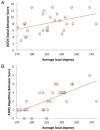Local functional overconnectivity in posterior brain regions is associated with symptom severity in autism spectrum disorders
- PMID: 24210815
- PMCID: PMC5708538
- DOI: 10.1016/j.celrep.2013.10.003
Local functional overconnectivity in posterior brain regions is associated with symptom severity in autism spectrum disorders
Abstract
Although growing evidence indicates atypical long-distance connectivity in autism spectrum disorder (ASD), much less is known about local connectivity, despite conjectures that local overconnectivity may be causally involved in the disorder. Using functional connectivity MRI and graph theory, we found that local functional connectivity was atypically increased in adolescents with ASD in temporo-occipital regions bilaterally. Posterior overconnectivity was found to be associated with higher ASD symptom severity, whereas an ASD subsample with low severity showed frontal underconnectivity. The findings suggest links between symptomatology and local connectivity, which vary within the autism spectrum.
Copyright © 2013 The Authors. Published by Elsevier Inc. All rights reserved.
Figures


Comment in
-
Convergent evidence of brain overconnectivity in children with autism?Cell Rep. 2013 Nov 14;5(3):565-6. doi: 10.1016/j.celrep.2013.10.043. Cell Rep. 2013. PMID: 24238089 Free PMC article.
References
-
- Amaral DG, Schumann CM, Nordahl CW. Neuroanatomy of autism. Trends Neurosci. 2008;31:137–145. - PubMed
-
- American Psychiatric Association. Diagnostic and Statistical Manual of Mental Disorders - IV - TR. 4th. Washington, DC: American Psychiatric Association; 2000.
-
- Belmonte MK, Cook EH, Jr, Anderson GM, Rubenstein JL, Greenough WT, Beckel-Mitchener A, Courchesne E, Boulanger LM, Powell SB, Levitt PR, et al. Autism as a disorder of neural information processing: Directions for research and targets for therapy. Mol Psychiatry. 2004b;9:646–663. - PubMed
Publication types
MeSH terms
Grants and funding
LinkOut - more resources
Full Text Sources
Other Literature Sources

